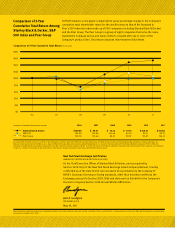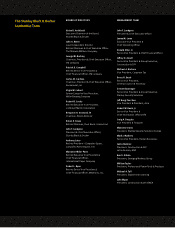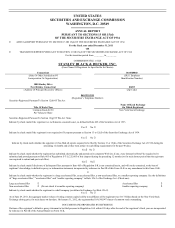Black & Decker 2011 Annual Report Download - page 19
Download and view the complete annual report
Please find page 19 of the 2011 Black & Decker annual report below. You can navigate through the pages in the report by either clicking on the pages listed below, or by using the keyword search tool below to find specific information within the annual report.7
Changes in customer preferences, the inability to maintain mutually beneficial relationships with large customers, inventory
reductions by customers, and the inability to penetrate new channels of distribution could adversely affect the Company’s business.
The Company has certain significant customers, particularly home centers and major retailers, although no one customer represented
more than 10% of consolidated net sales in 2011. However, the two largest customers comprised nearly 16% of net sales, with
U.S. and international mass merchants and home centers collectively comprised approximately 23% of net sales. The loss or material
reduction of business, the lack of success of sales initiatives, or changes in customer preferences or loyalties, for the Company’s
products related to any such significant customer could have a material adverse impact on the Company’s results of operations and
cash flows. In addition, the Company’s major customers are volume purchasers, a few of which are much larger than the Company
and have strong bargaining power with suppliers. This limits the ability to recover cost increases through higher selling prices.
Furthermore, unanticipated inventory adjustments by these customers can have a negative impact on sales.
If customers in our electronic security solutions business are dissatisfied with our services and switch to competitive services, or
disconnect for other reasons, our attrition rates may increase. In periods of increasing attrition rates, recurring revenue and results of
operations may be materially adversely affected. The risk is more pronounced in times of economic uncertainty, as customers may
reduce amounts spent on the products and services we provide.
In times of tough economic condition, the Company has experienced significant distributor inventory corrections reflecting de-
stocking of the supply chain associated with difficult credit markets. Such distributor de-stocking exacerbated sales volume declines
pertaining to weak end user demand and the broader economic recession. The Company’s results may be adversely impacted in future
periods by such customer inventory adjustments. Further, the inability to continue to penetrate new channels of distribution may have
a negative impact on the Company’s future results.
The Company faces active global competition and if it does not compete effectively, its business may suffer.
The Company faces active competition and resulting pricing pressures. The Company’s products compete on the basis of, among other
things, its reputation for product quality, its well-known brands, price, innovation and customer service capabilities. The Company
competes with both larger and smaller companies that offer the same or similar products and services or that produce different
products appropriate for the same uses. These companies are often located in countries such as China, Taiwan and India where labor
and other production costs are substantially lower than in the U.S., Canada and Western Europe. Also, certain large customers offer
house brands that compete with some of the Company’s product offerings as a lower-cost alternative. To remain profitable and defend
market share, the Company must maintain a competitive cost structure, develop new products and services, lead product innovation,
respond to competitor innovations and enhance its existing products in a timely manner. The Company may not be able to compete
effectively on all of these fronts and with all of its competitors, and the failure to do so could have a material adverse effect on its sales
and profit margins.
SFS is a continuous operational improvement process applied to many aspects of the Company’s business such as procurement,
quality in manufacturing, maximizing customer fill rates, integrating acquisitions and other key business processes. In the event the
Company is not successful in effectively applying the SFS disciplines to its key business processes, including those of acquired
businesses, its ability to compete and future earnings could be adversely affected.
In addition, the Company may have to reduce prices on its products and services, or make other concessions, to stay competitive and
retain market share. Price reductions taken by the Company in response to customer and competitive pressures, as well as price
reductions and promotional actions taken to drive demand that may not result in anticipated sales levels, could also negatively impact
its business. The Company engages in restructuring actions, sometimes entailing shifts of production to low-cost countries, as part of
its efforts to maintain a competitive cost structure. If the Company does not execute restructuring actions well, its ability to meet
customer demand may decline, or earnings may otherwise be adversely impacted; similarly if such efforts to reform the cost structure
are delayed relative to competitors or other market factors the Company may lose market share and profits.
Customer consolidation could have a material adverse effect on the Company’s business.
A significant portion of the Company’s products are sold through home centers and mass merchant distribution channels in the
U.S. and Europe. A consolidation of retailers in both North America and abroad has occurred over time and the increasing size and
importance of individual customers creates risk of exposure to potential volume loss. The loss of certain larger home centers as
customers would have a material adverse effect on the Company’s business until either such customers were replaced or the Company
made the necessary adjustments to compensate for the loss of business.
























